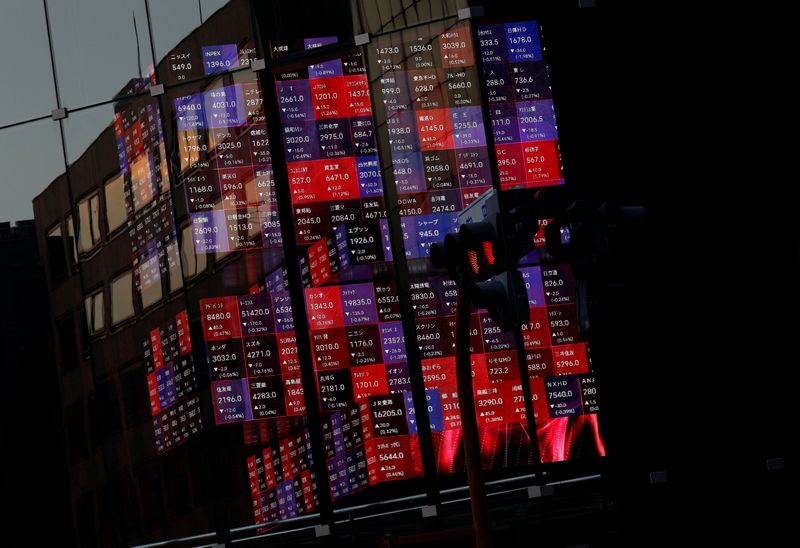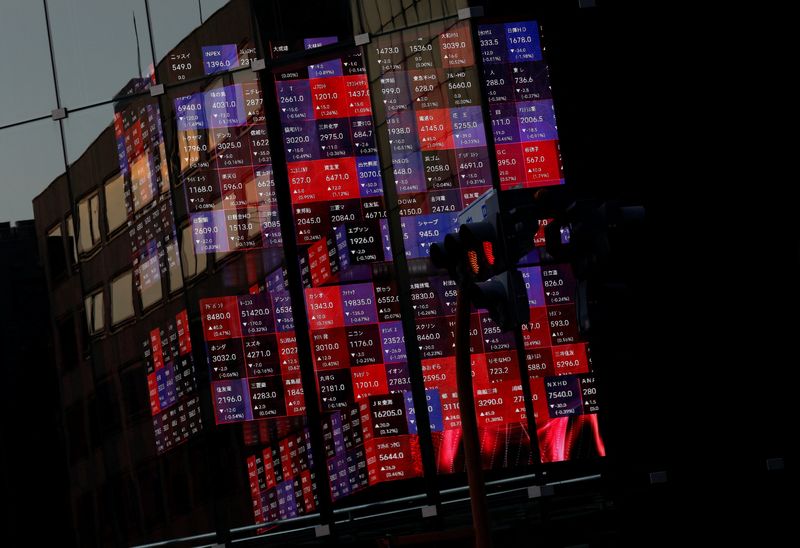Economy
Wall Street dips, the dollar strengthens as inflation data looms


© Reuters. A huge electric stock quotation board is seen inside a building in Tokyo, Japan, December 30, 2022. REUTERS/Issei Kato
By Stephen Culp
NEW YORK (Reuters) -Wall Street softened and the dollar rebounded on Tuesday as investors looked ahead to key inflation data and further clues regarding the duration of the U.S. Federal Reserve’s restrictive monetary policy.
All three major U.S. stock indexes started the session in negative territory, with Oracle Corp (NYSE:) weighing on sentiment after the cloud services company forecast weaker-than-expected current quarter revenue, hinting at a broader softening of demand.
At the forefront of market participants’ minds is the crucial Consumer Price Index (CPI) report expected on Wednesday, which should shed further light on the slow, downward path of inflation and provide some clarity regarding the direction of key interest rates.
One week from today, the central bank is due to convene its two-day policy meeting, at which the Fed is broadly expected to let current key interest rates stand.
“People are in a holding pattern waiting to understand policy, and policy goes back to inflation, the labor market, prices and consumer demand,” said Bill Merz, head of capital markets research at U.S. Bank Wealth Management in Minneapolis. “The Fed is also in wait and see mode, they need to see how data evolves before claiming victory.”
“(The Fed has) made good progress so far; it’s that last mile of getting from 3% or 4% to 2%, that’s grabbing the attention of investors,” Merz added.
The fell 65.05 points, or 0.19%, to 34,598.67, the lost 18.73 points, or 0.42%, to 4,468.73 and the dropped 86.98 points, or 0.62%, to 13,830.91.
European shares and were last slightly lower as strength in healthcare stocks was countered by tech weakness in the wake of Oracle revenue forecast.
The pan-European index lost 0.16% and MSCI’s gauge of stocks across the globe shed 0.33%.
Emerging market stocks lost 0.21%. MSCI’s broadest index of Asia-Pacific shares outside Japan closed 0.18% lower, while rose 0.95%.
The greenback regained some ground against a basket of world currencies as the yen gave back some gains that were driven by comments from Japan’s top banker suggesting a possible end to its negative interest rate policy.
“We would expect more currency volatility as we get to the point in the monetary cycle when central banks aren’t moving in concert anymore, and we start to see more local differences that influence monetary decision-making processes,” Merz said.
The rose 0.26%, with the euro down 0.32% to $1.0714.
The Japanese yen weakened 0.41% versus the greenback at 147.20 per dollar, while sterling was last trading at $1.2466, down 0.34% on the day.
U.S. Treasury yields were range-bound ahead of the Labor Department’s CPI report.
Benchmark 10-year notes last fell 2/32 in price to yield 4.2941%, from 4.288% late on Monday.
The 30-year bond last fell 2/32 in price to yield 4.3801%, from 4.377% late on Monday.
Oil prices surged on a tighter supply outlook and a sunny global demand outlook from OPEC.
rose 1.99% to $89.03 per barrel and was last at $92.08, up 1.59% on the day.
Gold prices retreated to a more than two-week low, weighed down by the strengthening greenback.
dropped 0.6% to $1,911.10 an ounce.
Economy
Russian central bank says it needs months to make sure CPI falling before rate cuts -RBC


© Reuters. Russian Central Bank Governor Elvira Nabiullina attends a news conference in Moscow, Russia June 14, 2019. REUTERS/Shamil Zhumatov/File Photo
MOSCOW (Reuters) – Russia’s central bank will need two to three months to make sure that inflation is steadily declining before taking any decision on interest rate cuts, the bank’s governor Elvira Nabiullina told RBC media on Sunday.
The central bank raised its key interest rate by 100 basis points to 16% earlier in December, hiking for the fifth consecutive meeting in response to stubborn inflation, and suggested that its tightening cycle was nearly over.
Nabiullina said it was not yet clear when exactly the regulator would start cutting rates, however.
“We really need to make sure that inflation is steadily decreasing, that these are not one-off factors that can affect the rate of price growth in a particular month,” she said.
Nabiullina said the bank was taking into account a wide range of indicators but primarily those that “characterize the stability of inflation”.
“This will take two or three months or more – it depends on how much the wide range of indicators that characterize sustainable inflation declines,” she said.
The bank will next convene to set its benchmark rate on Feb. 16.
The governor also said the bank should have started monetary policy tightening earlier than in July, when it embarked on the rate-hiking cycle.
Economy
China identifies second set of projects in $140 billion spending plan


© Reuters. FILE PHOTO: Workers walk past an under-construction area with completed office towers in the background, in Shenzhen’s Qianhai new district, Guangdong province, China August 25, 2023. REUTERS/David Kirton/File Photo
SHANGHAI (Reuters) – China’s top planning body said on Saturday it had identified a second batch of public investment projects, including flood control and disaster relief programmes, under a bond issuance and investment plan announced in October to boost the economy.
With the latest tranche, China has now earmarked more than 800 billion yuan of its 1 trillion yuan ($140 billion) in additional government bond issuance in the fourth quarter, as it focuses on fiscal steps to shore up the flagging economy.
The National Development and Reform Commission (NDRC) said in a statement on Saturday it had identified 9,600 projects with planned investment of more than 560 billion yuan.
China’s economy, the world’s second largest, is struggling to regain its footing post-COVID-19 as policymakers grapple with tepid consumer demand, weak exports, falling foreign investment and a deepening real estate crisis.
The 1 trillion yuan in additional bond issuance will widen China’s 2023 budget deficit ratio to around 3.8 percent from 3 percent, the state-run Xinhua news agency has said.
“Construction of the projects will improve China’s flood control system, emergency response mechanism and disaster relief capabilities, and better protect people’s lives and property, so it is very significant,” the NDRC said.
The agency said it will coordinate with other government bodies to make sure that funds are allocated speedily for investment and that high standards of quality are maintained in project construction.
($1 = 7.1315 renminbi)
Economy
Russian central bank says it needs months to make sure CPI falling before rate cuts -RBC


© Reuters. Russian Central Bank Governor Elvira Nabiullina attends a news conference in Moscow, Russia June 14, 2019. REUTERS/Shamil Zhumatov/File Photo
MOSCOW (Reuters) – Russia’s central bank will need two to three months to make sure that inflation is steadily declining before taking any decision on interest rate cuts, the bank’s governor Elvira Nabiullina told RBC media on Sunday.
The central bank raised its key interest rate by 100 basis points to 16% earlier in December, hiking for the fifth consecutive meeting in response to stubborn inflation, and suggested that its tightening cycle was nearly over.
Nabiullina said it was not yet clear when exactly the regulator would start cutting rates, however.
“We really need to make sure that inflation is steadily decreasing, that these are not one-off factors that can affect the rate of price growth in a particular month,” she said.
Nabiullina said the bank was taking into account a wide range of indicators but primarily those that “characterize the stability of inflation”.
“This will take two or three months or more – it depends on how much the wide range of indicators that characterize sustainable inflation declines,” she said.
The bank will next convene to set its benchmark rate on Feb. 16.
The governor also said the bank should have started monetary policy tightening earlier than in July, when it embarked on the rate-hiking cycle.

 Forex3 years ago
Forex3 years agoForex Today: the dollar is gaining strength amid gloomy sentiment at the start of the Fed’s week

 Forex3 years ago
Forex3 years agoUnbiased review of Pocket Option broker

 Forex3 years ago
Forex3 years agoDollar to pound sterling exchange rate today: Pound plummeted to its lowest since 1985

 Forex3 years ago
Forex3 years agoHow is the Australian dollar doing today?

 Cryptocurrency3 years ago
Cryptocurrency3 years agoWhat happened in the crypto market – current events today

 World3 years ago
World3 years agoWhy are modern video games an art form?

 Commodities3 years ago
Commodities3 years agoCopper continues to fall in price on expectations of lower demand in China

 Economy3 years ago
Economy3 years agoCrude oil tankers double in price due to EU anti-Russian sanctions

























